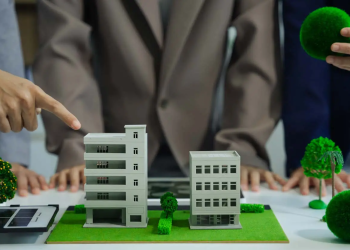In architecture, a floor is a levelled surface that supports the weights of household items as well as the occupants. Different materials can be used in the construction of floors. Among these materials are sustainable contents. Contrary to common beliefs, sustainable or eco-friendly flooring options are just as attractive and high quality as their counterparts.
In this post, we will discuss the various types of durable flooring materials used in construction.
1. Composite Decking Boards
Decking boards are constructed from wood, and plastic decking boards are made from even less sustainable materials. Plastic decking boards are cheap, but they are not as good for the environment. Composite decking boards are made are from recycled materials. They are attractive and easy to install and maintain. Another benefit of these forms of decking boards is the fact that they are resistant to splinters and rot and are available in a wide range of colours and designs.
2. Bamboo
Bamboo floors are fast gaining popularity in the industry. When you hear the word bamboo, the first thought that comes to mind is wood. However, bamboo is grass with similar elements as hardwood.
Bamboo falls under the sustainable material category because it is sourced from natural vegetation that can grow back to maturity in half a decade or less. Compared to regular trees that take more than two decades to mature, bamboo is more suitable. Like hardwood, bamboo decking floors are durable and effortless in terms of maintenance. They are also very easy to install.
Bamboo is also a very light material and features grains of different elements and a wide range of colours. This fact makes them more attractive than conventional flooring materials and used in construction.
3. Hardwood
Hardwood floors are quite common. However, they have been faulted for causing deforestation and not being sustainable. For this reason, lovers of hardwood flooring have opted for reclaimed hardwood and FSC-certified hardwood. Reclaimed hardwood is that which is obtained from reusing wood that had been gotten from formerly chopped down trees.
FSC certified hardwood is wood that is sold and approved by the Forest Stewardship Council. This association seeks to promote responsible forest management. Sustainable hardwood is equally as attractive as traditional hardwood. It is also open to various customisation techniques, incredibly durable and unique.
4. Cork
Cork is also obtained from trees. It is harvested from the barks of cork oak trees found in the Mediterranean forest. Cork is mainly used as covers for bottles of wines. In construction, cork was traditionally used on walls. However, more recently, floors made of cork have become an option.
Cork is considered sustainable since the trees from which they are harvested do not have to be cut down, and the affected barks can grow back in a couple of years. In addition to being very attractive, cork contains anti-microbial components that help to reduce allergens in the house. Cork is also a fire retardant, easy to maintain, and has some insect repellent features.
Cork can be used in different parts of the house. They can last anytime between ten to thirty years.
5. Carpet
There are different forms of carpets in the market. It is important to note that not all these forms are sustainable. Sustainable flooring carpets are made from natural fibres, the likes of wool, sisal, seagrass, and jute. These fibres also require close to no chemical treatment. Carpets made from recycling materials also fall under this category.
Another option for sustainable carpeting is polyester, Berber. This material is made from recycled plastic bottles and has minimal to no negative impact on the environment. This carpet is durable, resistant to spills and moisture and is available in a variety of pleasing patterns and colours.
Other elements of eco-friendly carpets include the fact that they are made with a low volatile organic compound with non-toxic dyes. Sustainable carpets are also easy to clean and can last for several years. Eco-friendly carpets also feature backs that can be separated from the carpet for natural recycling endeavours.
6. Glass Tiles
Glass tiles are made from recycled wine and beer bottles, hence the sustainability element. Like other sustainable materials, glass tiles are resistant to moisture, repellent to mildew, and mould. Glass is also available in a wide range of colours, patterns, and designs. It doesn’t stain and is easy to maintain.
One flaw that other modes of tiles like ceramic tiles have is the fact that they absorb light. However, glass tiles are known to reflect light and not absorb it. Another benefit of using glass tiles is the fact that it adds brightness to the rooms where they are installed.
7. Vinyl Tiles
Vinyl tiles resemble stone, ceramic, and hardwood flooring contents. In addition to being highly sustainable, vinyl tiles are high-end and luxurious. Vinyl tiles are also available in a variety of textures, colours, and designs, each of which is unique from the other.
Vinyl tiles are certified over the fact that they emit meagre amounts of VOC, are responsibly manufactured. They also provide safe indoor air quality.
8. Linoleum
Linoleum is often mistaken for vinyl. Unlike vinyl, linoleum is made from a mixture of linseed oil, cork dust, and resin from trees. All these materials are highly eco-friendly. Some of the benefits of linoleum include the fact that it is resistant to water and fire. Linoleum flooring is also available in a wide range of brilliant colours.
One of the main flaws of linoleum is the fact that it is prone to staining. However, the issue can be resolved by using a sealant on the flooring that protects it from stains. Finally, linoleum is highly durable.
Elements of Sustainable Flooring Options Used in Construction
Below are the main features of sustainable flooring materials:
• The flooring contents are renewable and recyclable
• The methods of manufacturing these flooring materials do not cause any harm to the environment
• The distance which the raw materials are transported to the manufacturers should also be minimal because transportation options can cause damage to the environment
• The flooring materials are easy to maintain and have a long life cycle
• The materials are not toxic to the environment.
Bottom Line
Some of the benefits of using sustainable flooring materials include the fact that they are beautiful, durable, and non-toxic to the environment. Sustainable flooring materials are also available in a wide range and are some of the unique options in the market.









Comments 2